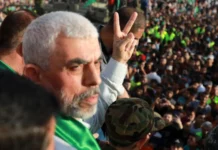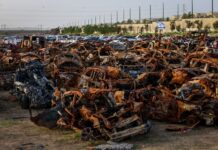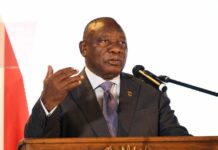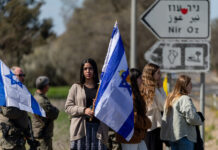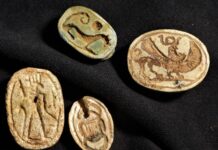As the specter of escalation in the Middle East looms ever larger, it’s well worth remembering that the government of Iran doesn’t represent those it presumes to speak for: the people of Iran.
Many Iranians believe their government is more interested in starting fires abroad than putting out the inferno at home. In its neverending war against Israel, Iran prefers to use Arab clients, but Iranians pay a price for this belligerency in other ways—not least literally.
The regime diverts billions of dollars a year to its “Axis of Resistance,” which includes Hezbollah, Hamas and the Houthis. Meanwhile, the Iranian people languish in a mismanaged economy of inflation, poverty and unemployment.
Popular sloganeering reflects this discontent. Iranians have been rallying for decades under slogans like “Forget Palestine! Think about us!” and the less subtle “Death to Palestine!” One slogan in particular—“Neither Gaza nor Lebanon. My life for Iran!”—has been a favorite of Iranian protestors since late 2008.
The bitterness behind such slogans sometimes crosses over into the anti-Arab bias that has existed in Iran ever since the Islamic conquests. The slur Arab-parastan (“Arab worshippers”), for example, is sometimes leveled at regime officials and loyalists by their opponents.
For all this popular resentment, the Iranian regime’s support for Arab terrorism is the least of Iranian grievances. While a majority of its population disapproves of Iran’s leadership, as Gallup polls have repeatedly attested, discontent runs much deeper. They don’t just oppose their leaders but also the Islamic Republic itself.
Iran’s best-known political scientist, the regime-supporter-turned-political-prisoner Sadegh Zibakalam, has speculated that if a referendum were held on abolishing the Islamic Republic, 70% of Iranians would vote the regime into oblivion. An internal study by the regime’s Ministry of Culture and Islamic Guidance leaked in February bears him out: It found that 73% of Iranians favor decoupling religion from governance.
The Iranian regime, needless to say, would never go for such a vote. The only voting it allows has little practical effect and, therefore, little popular appeal.
In the theater that is Iranian elections, the 12-man Guardian Council, its members chosen directly and indirectly by the supreme leader, is the casting director that hand-picks who can run. Of the 80 hopefuls who registered as candidates in June’s presidential election, the Guardian Council disqualified all but six. Unsurprisingly, the election itself proved to be a performance for which many didn’t even bother showing up; turnout didn’t even crack 40%.
Instead of voting at the polls, many Iranians simply vote with their feet and emigrate. Every year, a brain drain deprives the Iranian economy of 150,000-180,000 highly skilled professionals who leave for North America or Europe, a human capital flight that is Iran’s loss and the West’s gain. Many of those left behind want out too.
The dynamic between the regime and its most bitter opponents is like that between the protagonist of the Iranian national epic, the Shahnameh, and a mythical being he encounters. “If I say one thing, he’ll do the opposite,” he says of this contrarian creature. In the same spirit, there are not a few Iranians who seem to relish whatever the regime reviles.
In the “physics” of this relationship, the regime’s repulsion is its opponents’ attraction. The Iranian government has denounced the United States as “the Great Satan” and led chants of “Death to America” at mass assemblies. Its proxies have killed more Americans than any other terrorist organization except Al-Qaeda.
Yet the Iranian population is the most pro-American in the region after Israel’s. Despite the regime’s virulent hatred of Israel and Jews, the Iranian people are, according to the ADL, the least antisemitic in the world’s most antisemitic region.
The same oppositional impulse asserts itself when it comes to Israel. Although the Iranian government has pursued Israel’s destruction as a sacred duty, more than a third of Iranians are favorably disposed towards the Jewish state, a larger proportion than in many European countries.
Sympathizers are common in the Iranian diaspora, where expressing support for Israel isn’t considered high treason. After the Oct. 7 massacre, Iranian demonstrations in solidarity with Israel sprang up in the U.S., Canada, Belgium, France and Germany. On April 13, the day of Iran’s drone and missile attack on Israel, the hashtag #IraniansStandWithIsrael racked up more than 60,000 uses on X.
Nothing is more damning for the Islamic Republic than that it has turned many Iranians away from Islam itself. Many Iranians have simply abandoned their religion altogether, embracing secularism, reverting to the pre-Islamic religion of their ancestors—Zoroastrianism—or even converting to Christianity. This devastating verdict on the mullahs’ rule proves that in Iran as in other theocracies, there is no greater enemy of religion than religious government.
Given the chasm between Iran’s rulers and the ruled, to conflate Iran’s government and its people is to do the government a service and the people an injustice. It legitimizes a government that has no mandate for its rule and insults the people by suggesting that a kakistocracy (government by the worst) is the best Iranians can do. Indeed, the Islamic Republic isn’t just unrepresentative of a people that has bestowed countless gifts on humanity, it’s unworthy of them.
When it was established in 1979, the Islamic Republic took two groups hostage: Several dozen Americans and the Iranian people themselves. The ordeal of the Americans wore on for 444 hellish days before they were released. As for the Iranian people, their captivity endures. They and the world’s many Iran-doostan (“friends of Iran”) await their liberation.




